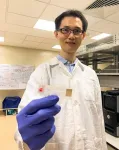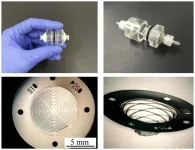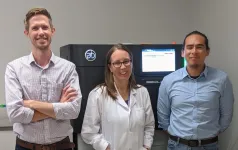(Press-News.org) A team of scientists from Nanyang Technological University, Singapore (NTU Singapore) has developed a test kit for malaria that delivers results in 30 minutes. The kit could facilitate the diagnosis of malaria in the field, as the equipment needed is anticipated to be lightweight, easy-to-use, and able to detect the disease in its early stages.
According to the World Health Organisation (WHO), an estimated 229 million people suffered from malaria in 2019. The disease, transmitted by mosquitoes, caused the deaths of 409,000 people across 87 mainly developing countries.
Efforts to treat and control malaria in developing countries and rural areas are hindered by high cost and the lack of infrastructure. Rapid diagnostic tests (RDTs) for malaria are unable to detect infections during the early stages of the disease, but can give false positive or negative results. They also do not determine the severity of the infection.
Associate Professor Liu Quan, from NTU's School of Chemical and Biomedical Engineering, who led the study, said: "Compared to current solutions, the NTU-developed test kit is able to detect malaria infections even when the number of parasites in the blood are low, especially during the early stages of the disease. It is also able to quantify the number of parasites in every test, which allows physicians to monitor their patients' progress in fighting the disease.
"We hope this could help in malaria control and elimination. The goal of our test was to reduce the reliance on lab equipment for the detection of malaria, which is an important step towards malaria field diagnosis. We had a simple goal in mind - to find a tool that can be produced at a low cost and was accurate enough to do quick screening."
Assessing the test, Professor Laurent Renia, Director of the Respiratory and Infectious Diseases Programme at NTU's Lee Kong Chian School of Medicine who was not part of the study, said: "The NTU test kit would help fill the gap in malaria detection for a tool that is accurate, sensitive, fast and cheap. As the team's test kit would be easily deployable, operable without extensive training, and would not rely on the usage of microscopes, it could be useful for malaria specialists that are conducting research remotely or clinicians without access to laboratory equipment."
The study was published in the peer-reviewed scientific journal Sensors and Actuators B: Chemical in May. The NTU team has filed a patent application for their technology, on top of an earlier patent they obtained in 2017.
Digested blood - the key to the test's effectiveness
Microscopic examination of blood infected with malaria parasites remains the current global benchmark to confirm an infection. However, this requires microscopes and a level of expertise to conduct the process, which are both often not available in many health facilities in several malaria-endemic countries and rural areas.
The made-in-NTU test kit could reduce researchers' reliance on complex laboratory equipment as it would only require a blood sample and water to operate (see Image 1). The kit works by detecting hemozoin, a by-product formed from the digestion of blood by malaria parasites, which is a unique indicator of the disease.
First, ten microlitres of a patient's blood, which is less than a drop of water, is mixed with water to force red blood cells to release the parasites contained.
A pump within the test kit then sucks in the blood mixture to bring it in contact with several chemical patches, which cause hemazoin to light up. The flashes of light are then picked up by a detector, known as a Raman spectrometer, which determines whether an infection is present or not, as well as its severity.
To validate the accuracy of the test kit, the researchers loaded human blood infected with malaria parasites into the chip. The test could detect early stage parasites at a level of 125 parasites per microlitre of blood, which is a higher sensitivity than currently available rapid diagnostic tests.
The researchers estimate that each test would cost about US$1 per chip to manufacture and at this price would facilitate low-cost point-of-care field testing on a large scale.
The team hopes to find an industry partner to work with and to conduct further trials on their malaria test kit to improve its sensitivity and functionality.
INFORMATION:
A microfilter device that can easily separate and capture trace amounts of cancer cells in blood has been developed by a Kumamoto University research group. The palm-sized device is expected to contribute to the development of new cancer diagnostic technologies based on cancer cells in the blood, such as early detection by blood test, postoperative management, and recurrence monitoring.
The blood of people with cancer contains trace amounts of cancer cells (CTCs) that have detached from the primary cancer site. However, the amount of these cells is only a few per milliliter, whereas red or white blood cells number in the billions, making ...
INDIANAPOLIS - With the growing prevalence of chronic pain, depression, anxiety, and other symptom-based conditions, physicians and the healthcare systems for which they work are increasingly considering how to augment the care they can provide within the limited time allotted for patient appointments.
According to Regenstrief Institute Research Scientist Kurt Kroenke, M.D., writing in the Journal of General Internal Medicine (JGIM), collaborative care can and should play a major role targeting the treatment of symptoms and functional decline, both too frequently marginalized in medically oriented care delivery.
Collaborative care is a team-based ...
Neoadjuvant immune checkpoint blockade (ICB) is a promising treatment for melanoma and other cancer types, and has recently been shown to provide a modest survival benefit for patients with recurrent glioblastoma. To improve the treatment efficacy, researchers are looking for vulnerabilities in surgically removed glioblastoma tissues, but this has been difficult due to the vast differences within the tumor and between patients.
To address this challenge, researchers at Institute for Systems Biology (ISB) and their collaborators developed a new way to study tumors. The method builds ...
Sophia Antipolis - 29 June 2021: Heart attacks during the COVID-19 pandemic were more likely to result in heart failure compared with heart attacks one year earlier, according to research presented today at Heart Failure 2021, an online scientific congress of the European Society of Cardiology (ESC).1
"Heart attack patients waited an average of 14 hours to get help during the pandemic, with some delaying for nearly two days. That compares to a delay of six hours in the previous year," said study author Dr. Ali Aldujeli of the Hospital of Lithuanian University of Health Sciences, Kaunas, Lithuania. "This gap may have been one contributor to the higher incidence of subsequent heart failure."
Urgent treatment for heart attacks is essential to restore the flow of oxygen-rich ...
Scientists have for the first time detected black holes eating neutron stars, "like Pac Man", in a discovery documenting the collision of the two most extreme and enigmatic objects in the Universe.
The Laser Interferometer Gravitational-Wave Observatory (LIGO) in the US and the Virgo gravitational-wave observatory in Italy have captured the gravitational waves from the death spiral and merger of a neutron star with a black hole, not once but twice. The findings are published today.
The researchers say their observations will help unlock some of the most complex mysteries of the Universe, including the building blocks of matter and the workings of space and time.
More than 1,000 scientists were involved with the ...
As smoky air becomes more common during Washington's wildfire season, many wildlife enthusiasts wonder: What happens to the birds?
Few studies have looked at wildfire smoke impacts on animals, let alone birds. And as Washington and the larger West Coast continue to experience more massive wildfires and smoke-filled air, understanding how birds are affected by smoke -- and how air pollution may influence our ability to detect birds -- are important factors for bird conservation.
Researchers from the University of Washington now provide a first look at the probability of observing common birds as air pollution worsens during wildfire seasons. They found that smoke affected the ability to detect more than a third of the bird species studied ...
For the first time, researchers have confirmed the detection of a collision between a black hole and a neutron star. In fact, the scientists detected not one but two such events occurring just 10 days apart in January 2020. The extreme events made splashes in space that sent gravitational waves rippling across at least 900 million light-years to reach Earth. In each case, the neutron star was likely swallowed whole by its black hole partner.
Gravitational waves are disturbances in the curvature of space-time created by massive objects in motion. During the five years since the waves were first measured, a finding that led to the END ...
A long time ago, in two galaxies about 900 million light-years away, two black holes each gobbled up their neutron star companions, triggering gravitational waves that finally hit Earth in January 2020.
Discovered by an international team of astrophysicists including Northwestern University researchers, two events -- detected just 10 days apart -- mark the first-ever detection of a black hole merging with a neutron star. The findings will enable researchers to draw the first conclusions about the origins of these rare binary systems and how often they merge.
"Gravitational ...
Gravitational wave detectors have observed a new type of cataclysmic event in the cosmos: the merger of a neutron star with a black hole.
The phenomenon was detected twice in January 2020.
Several hypotheses could explain the existence of such mixed pairs. Further observations will be needed in order to settle the question.
Another missing piece has just been added to our knowledge of cosmic phenomena. The LIGO, Virgo and KAGRA collaborations have announced the first detection of gravitational waves (1) resulting from the 'mixed' merger between a black hole and a neutron star (2). The discovery, published on June 29, 2021 in Astrophysical Journal Letters, involves CNRS researchers working within ...
LOUISVILLE, Ky. - Historically, most large-scale immunogenomic studies - those exploring the association between genes and disease - were conducted with a bias toward individuals of European ancestry. Corey T. Watson, Ph.D., assistant professor in the University of Louisville Department of Biochemistry and Molecular Genetics, is leading a call to actively diversify the genetic resources he and fellow immunogenomics researchers use in their work to advance genomic medicine more equitably.
Watson, along with UofL post-doctoral fellow Oscar Rodriguez, Ph.D., and visiting fellow Yana Safonova, Ph.D., are part of an international group of researchers ...






